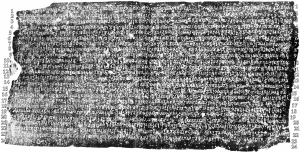First reported and briefly discussed in Peterson 1885: 380-381. First edited in Fleet 1886b. Re-edited in Fleet 1888. Corrected in Bhandarkar, R.G. 1889: 94-97. Further corrections in Kielhorn 1890 and in Durgaprasad Parab 1892: 107-112 (the inscription is in fact No. 26 in this book, not 51-52 as cited by Bhandarkar 1981: 322). Discussed and revised in Bühler 1890: 8-31 and 91-95; discussion translated to English in Bühler 1913: 137-148. Correction in Agrawal 1940: 60. Summarised in Trivedi 2001: 20 (No. 5). Further discussion in Diskalkar 1926: 176-178, Pisharoti 1936, Sharma 1937, Pisharoti 1938, Sharma 1938, Bose 1938: 327-328, Sharma 1939, Sadhu Ram 1964, Vajpeyi 1972, Mirashi 1980b, Basham 1983, Agrawal 1986b (also published as Agrawal 1986a: 79-86).
Peterson (1885)
380-381
Peterson, Peter. (1885). An Inscription from Kotah, Journal of the Bombay Branch of the Royal Asiatic Society, 16, pp. 378-389.
Fleet (1886b)
194-201
Fleet, J. F. (1886). Sanskrit and Old-Kanarese Inscriptions No. 162. Mandasor Inscription of Kumaragupta and Bandhuvarman: the Malava years 493 and 529, Indian Antiquary, 15, pp. 194-201.
Fleet (1888)
79-88, no. 18
Fleet, J. F. (1888). Inscriptions of the Early Gupta Kings and Their Successors. Calcutta: Superintendent of Government Printing.
Bhandarkar, R. G. (1889)
94-97
Bhandarkar, R. G. (1889). The Epoch of the Gupta Era, Journal of the Bombay Branch of the Royal Asiatic Society, 17, pt. 2, pp. 80-98.
Kielhorn (1890)
251-253
Kielhorn, Lorenz Franz. (1890). Die Mandasor Inschrift vom Mâlava Jahre 529 (=472 n. Chr.) und Kâlidâsa's Ṛitusaṁhâra. In: Nachrichten von der Königl. Gesellschaft der Wissenschaften und der Georg-Augusts-Universität zu Göttingen. Aus dem Jahre 1890. Göttingen: Dieterichsche Verlags-Buchhandlung.
Durgaprasad Parab (1892)
107-112
Durgâprasâd and Parab, Kâśînâth Pâṇḍurang. (1892). The Prâchîna-Lekha-Mâlâ or A Collection of Ancient Historical Records. Vol. I. (Kâvyamâlâ 34). Bombay: Nirnay Sagar Press.
Bühler (1890)
8-31, 91-96
Bühler, Georg. (1890). Die indische Inschriften und das Alter der indischen Kunstpoesie, Sitzungsberichte, 122, no. 11, pp. 1-97.
Bühler (1913)
137-148
Bühler, Georg. (1913). The Indian Inscriptions and the Antiquity of Indian Artificial Poetry, The Indian Antiquary, 42, pp. 29-37, 137-148, 172-179, 188-193, 230-234, 243-249.
Diskalkar (1926)
176-178
Diskalkar, D. B. (1926). Epigraphic Notes and Questions, Journal of the Bombay Branch of the Royal Asiatic Society, New Series 2, pp. 176-183.
Bhandarkar (1929)
2-3, nos. 6, 8
Bhandarkar, Devadatta Ramakrishna. (1929). A List of the Inscriptions of Northern India in Brahmi and its derivative Scripts, from about 200 A. C. (Appendix to Epigraphia Indica volumes XIX to XXIII). Calcutta: University of Calcutta.
Agrawal (1940)
60
Nath, J. (1940). Epigraphic Notes. In: Proceedings of the Indian History Congress. Fourth Session: Lahore, 1940. Lahore: Indian History Congress Association.
Pisharoti (1936)
69-73
Pisharoti, K. Rama.(1936). Vatsabhatti's Prasasti—A Fresh Study. In: Dr. S. Krishnaswami Aiyangar Commemoration Volume. Edited by V. Rangacharya et al. Madras: G. S. Press.
Sharma (1937)
379-381
Sharma, Dasharatha. (1937). The Mandasore Inscription of the Silk-Weavers' Guild, Indian Culture, 3, pp. 379-381.
Pisharoti (1938)
110-111
Pisharoti, K. Rama.(1938). Vatsabhaṭṭi's Praśasti, Indian Culture, 4, pp. 110-111.
Sharma (1938)
262-263
Sharma, Dasharatha. (1938). A Supplementary Note on the Mandasore Inscription of the Silk-Weavers' Guild, Indian Culture, 4, pp. 262-263.
Bose (1938)
327-328
Bose, Sushil K. (1938). Studies in Gupta Palaeography, Indian Culture, 4, pp. 181-188, 325-346.
Sharma (1939)
110
Sharma, Dasharatha. (1939). Vatsabhaṭṭi's Praśasti, Indian Culture, 6, p. 110.
Sadhu Ram (1964)
208-211
Sadhu Ram (1964). Epigraphical Notes, Brahmavidyā. The Adyar Library Bulletin, 28, pp. 208-211.
Sircar (1965)
(vol. 1) 299-307, bk. III, no. 24
Sircar, Dines Chandra. (1965). Select Inscriptions Bearing on Indian History and Civilization. Volume I: From the Sixth Century B.C. to the Sixth Century A.D. (Second Edition). Calcutta: University of Calcutta.
Vajpeyi (1972)
212-220
Vajpeyi, Raghavendra. (1972). A Note on the Term Catussamudrānta-Pṛthivī in the Mandasor Stone Inscription of Kumāragupta I, Annals of the Bhandarkar Oriental Research Institute, 53, pp. 212-220.
Mirashi (1980b)
405-426
Mirashi, Vasudev Vishnu. (1980). Further Light on Yaśodharman-Vishṇuvardhana. In: Bhāratī-bhānam (Light of Indology) being Dr. K.V. Sarma felicitation volume. (Panjab University Indological Series 26). Edited by S. Bhaskaran Nair. Hoshiarpur: Vishveshvaranand Vishva Bandhu Institute of Sanskrit and Indological Studies, Panjab University.
Bhandarkar (1981)
322-332, no. 35
Fleet, J. F., and Bhandarkar, D. R. (1981). Inscriptions of the Early Gupta Kings (Revised Edition). Edited by Bahadur Chand Chhabra and Govind Swamirao Gai. New Delhi: Archaeological Survey of India.
Agrawala (1983)
no. 40
Agrawala, Prithvi Kumar. (1983). Imperial Gupta Epigraphs (गुप्ताधिराजलेखमण्डल). Ancient Indian Epigraphical Sources (प्रत्नाभिलेखसंहिता) X.1. Varanasi: Books Asia.
Basham (1983)
93-105
Basham, A. L. (1983). The Mandasor Inscription of the Silk-Weavers. In: Essays on Gupta Culture. Edited by Bardwell L. Smith. Dehli/Varanasi/Patna: Motilal Banarsidass.
Agrawal (1986a)
79-86
Agrawal, Jagannath. (1986). Researches in Indian Epigraphy and Numismatics. Delhi: Sundeep Prakashan.
Agrawal (1986b)
53-58
Agrawal, Jagannath. (1986). A Study of Some Verses of the Mandasor Stone Inscription Dated Malava Year 529, Journal of the Royal Asiatic Society, 118, pp. 53-58.
Goyal (1993)
352-355
Goyal, Shri Ram. (1993). गुप्तकालीन अभिलेख/Guptakālīna Abhilekha (Inscriptions of the Gupta Age). Jodhpur: Kusumanjali Prakashan.
Trivedi (2001)
20, no. 5
Trivedi, Harihar Vitthal. (2001). Epigraphs of Madhya Pradesh. New Delhi: Director General, Archaeological Survey of India.
